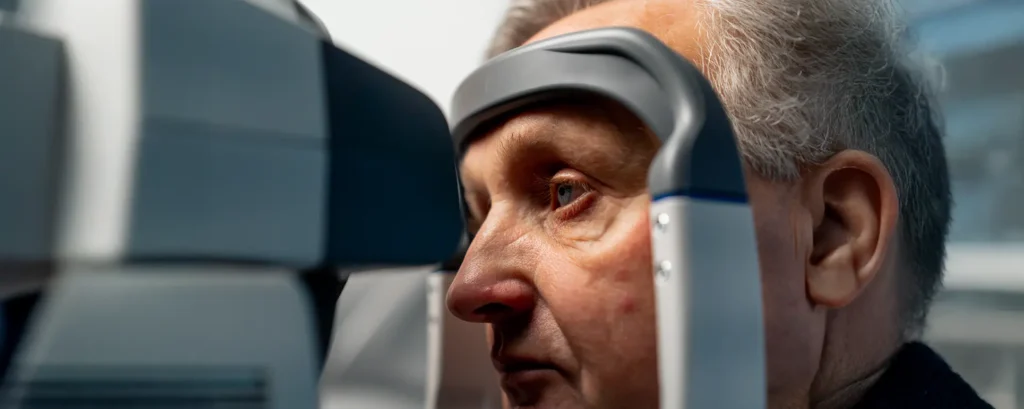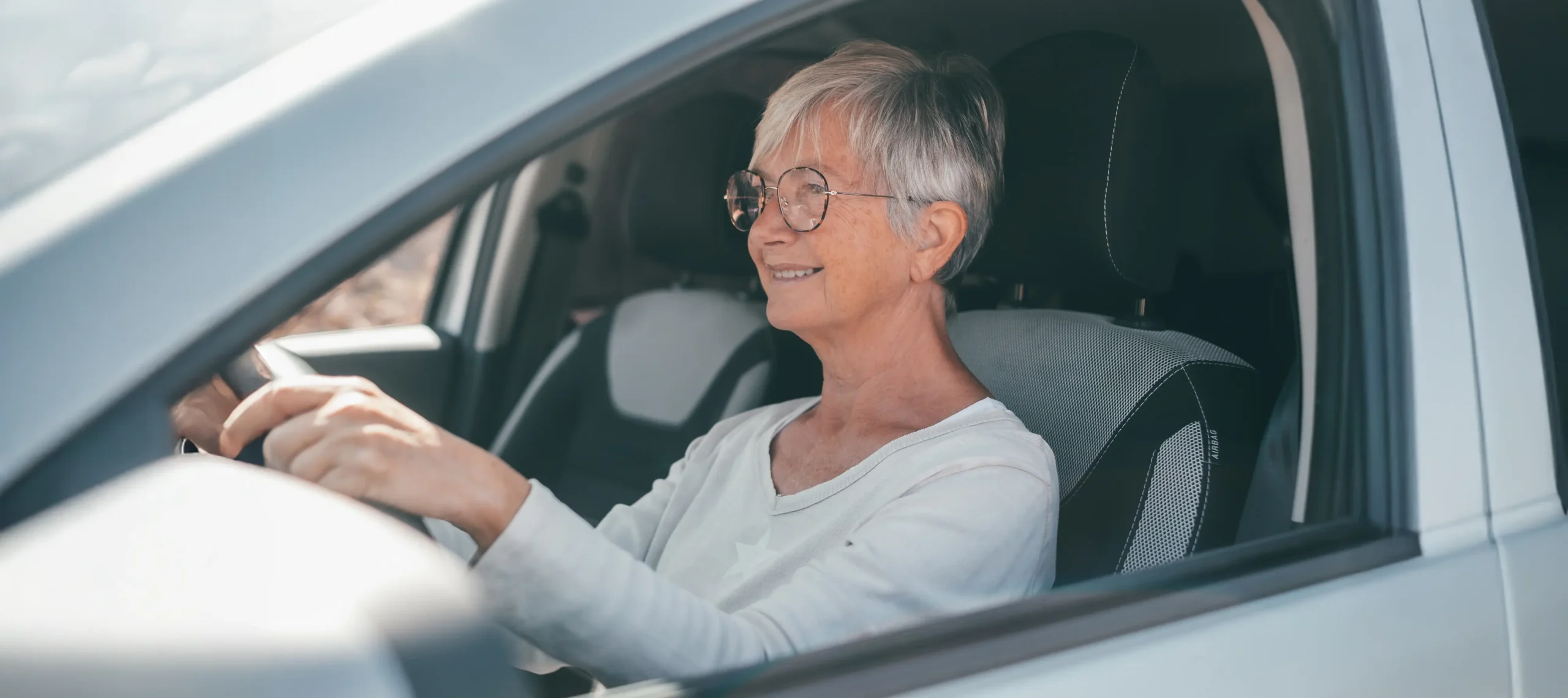If you’ve recently had cataract surgery, you may already know about posterior capsule opacification (PCO), sometimes referred to as a “secondary cataract.” It’s not actually a new cataract, but rather a clouding that develops on the capsule behind your lens implant. The good news is that it can be treated effectively with a quick outpatient procedure called YAG laser capsulotomy.
Understandably, one of the first questions patients ask after having this laser treatment is: “When can I drive again?” Driving represents freedom, independence, and for many people, an essential part of daily life. But because clear, safe vision is critical on the road, it’s important not to rush back too soon.
In this article, we’ll walk through what happens during YAG laser capsulotomy, how your vision may be affected afterwards, what the DVLA (Driver and Vehicle Licensing Agency) guidelines say, and some practical safety tips to help you decide when it’s safe to get back behind the wheel.
What Happens During YAG Laser Capsulotomy?

To understand why driving might be restricted after the procedure, let’s first break down what happens.
YAG laser capsulotomy is performed in the clinic and typically takes just a few minutes. The surgeon uses a focused YAG laser to create a tiny opening in the cloudy capsule that sits just behind your lens implant. By doing so, light can pass freely to the retina again, restoring your sharpness of vision.
The procedure itself is painless, as anaesthetic eye drops are applied beforehand. Most patients notice a rapid improvement in their sight, sometimes even within hours. However, in the short term, the laser may cause visual disturbances, such as new floaters, temporary glare, or blurred patches. This is why driving immediately after the procedure isn’t recommended — your vision needs time to stabilise.
How Vision Recovers After YAG Laser Treatment
Recovery is usually swift, but it can vary from one person to the next. For many, vision begins to clear within a few hours, while for others it may take a couple of days before things settle fully.
Immediately after the treatment, your pupil is often dilated with drops. This can make your vision blurry and increase glare sensitivity for several hours. You might also see floaters — small dark specks that drift across your vision — which are common following the laser procedure. While they often fade with time, they can be distracting at first.
These effects are temporary, but they matter when it comes to safe driving. Until your sight is clear and free from distracting disturbances, it’s important to hold off getting behind the wheel.
DVLA Driving Standards After YAG Laser Capsulotomy

In the UK, the DVLA sets minimum eyesight standards for driving. After YAG laser capsulotomy, you must meet these requirements before resuming driving.
For cars and motorbikes (Group 1 drivers), you need to:
- Be able to read a number plate at 20 metres (with glasses or contact lenses if required).
- Have a visual acuity of at least 6/12 on the Snellen scale in your better eye.
- Have an adequate field of vision.
For bus and lorry drivers (Group 2 licence holders), the standards are even stricter. If you fall into this group, your doctor will usually advise you to wait for formal clearance before driving again.
Even if your vision seems improved after YAG treatment, it’s essential not to drive until you’re confident that you meet these standards and can see clearly and comfortably.
Common Symptoms That May Delay Driving
While most patients recover quickly, there are a few symptoms that can make driving unsafe in the short term:
- Floaters: Seeing small shapes drifting across your vision can distract you while driving, particularly against bright backgrounds like the sky or road.
- Light sensitivity: Dilating drops or laser after-effects can make you more sensitive to headlights, traffic lights, or sunlight.
- Blurred patches: If the laser treatment stirs up debris in the eye, your vision may remain hazy for a few hours or days.
- Mild eye discomfort: Although not usually severe, some people experience irritation or a gritty feeling after the procedure, which can make concentrating harder.
Until these symptoms resolve, it’s best to avoid driving.
How Soon Can Most People Drive Again?
For many patients, normal driving can resume within 24 hours of the procedure, once the dilating drops have worn off and vision is stable. Some people even feel ready the next day. However, recovery is individual — there’s no single rule that fits everyone.
If your vision clears quickly, you may meet DVLA standards by the following day. Others may need to wait a little longer. It’s always worth checking your sight carefully at home first — for example, by reading text, judging distances, and testing glare tolerance — before attempting to drive.
Safety Tips Before Getting Back on the Road
When you feel your vision has improved enough to consider driving again, it’s wise to take a few precautions first:
- Test your sight indoors: Try reading fine print or watching TV subtitles clearly.
- Check distance vision: Look at road signs or number plates outside your home to make sure they’re sharp.
- Assess glare tolerance: Switch on bright lights in a dark room to simulate oncoming headlights.
- Go for a short local drive first: Try a quiet residential street or car park before venturing onto busier roads.
- Have someone with you: If possible, ask a friend or family member to accompany you on your first drive.
Taking these steps helps ensure that when you do return to driving, it’s both safe and comfortable.
Risks to Watch Out for After YAG Laser Treatment
Although YAG laser capsulotomy is generally very safe, there are a few rare risks that may impact driving if they occur. These include:
- Transient rise in eye pressure
- Swelling at the back of the eye (macular oedema)
- Retinal detachment (very rare, but serious)
Your ophthalmologist will usually check your eye pressure after the procedure and may schedule a follow-up visit. If you notice sudden flashes of light, a curtain-like shadow in your vision, or a rapid increase in floaters, you should seek urgent attention — and absolutely avoid driving until reviewed.
Psychological Confidence in Driving Again
Driving isn’t just about having the physical ability to see clearly; it’s also about feeling confident. Some people feel hesitant after any eye procedure, even if their vision meets all standards. That’s completely normal.
Taking your time and easing back into driving gradually can help rebuild confidence. Start with familiar routes, avoid night driving initially if glare is bothersome, and only progress to longer journeys once you feel fully at ease.
FAQ Section
1. Can I drive myself home after YAG laser capsulotomy?
No, you shouldn’t drive home immediately after the procedure. Your pupils will be dilated, your vision may be blurry, and you could be sensitive to light, making driving unsafe. Arrange for someone to accompany you or use public transport or a taxi.
2. How long should I wait before considering driving again?
Most patients are advised to wait at least 24 hours before driving. This allows the dilating drops to wear off and gives your vision time to stabilise. Some may recover faster, while others need a little longer.
3. What if I still see floaters after the treatment?
Floaters are common after YAG laser treatment. While many fade with time, they can be distracting initially. If you feel they interfere with your concentration or safety on the road, wait until they improve before driving.
4. Do I need to inform the DVLA about my YAG treatment?
In most cases, you don’t need to tell the DVLA about routine YAG laser capsulotomy. However, you must not drive until your vision meets the required standards, and you should always follow your doctor’s advice.
5. What if I drive for a living — does this change things?
Yes, if you hold a Group 2 licence for lorries or buses, stricter standards apply. Your ophthalmologist may recommend a longer recovery period and possibly additional eye checks before you can return to professional driving.
6. Is it safe to drive at night after YAG laser treatment?
Night driving can be more challenging due to glare and halos from lights. Even if you feel fine during the day, it’s best to test your tolerance to glare first and only attempt night driving once you’re fully comfortable.
7. Can my glasses prescription change after YAG laser capsulotomy?
Sometimes your optician may suggest updating your glasses after YAG treatment, as vision clarity can improve. It’s a good idea to wait a few weeks for your sight to stabilise before getting new lenses.
8. What if I feel nervous about driving again?
It’s completely normal to feel hesitant. Start with short, quiet routes and build up gradually. Having a friend or family member in the car at first can also help restore your confidence.
9. Could the treatment affect my peripheral vision for driving?
YAG capsulotomy is designed to clear central vision rather than affect peripheral sight. However, if you notice any loss of side vision after treatment, seek medical review before driving.
10. What should I do if I notice sudden changes in my vision after I’ve started driving again?
If you experience flashes of light, a sudden increase in floaters, or a curtain-like shadow in your vision, stop driving immediately and contact your eye doctor. These could be signs of retinal detachment, which requires urgent treatment.
Final Thoughts
YAG laser capsulotomy is a straightforward, highly effective procedure that restores clear sight for people affected by posterior capsule opacification. For most, driving can resume safely within a day or two, once the effects of dilating drops wear off and vision stabilises.
The key is to make sure you meet DVLA standards, feel comfortable, and don’t ignore any symptoms that might compromise safety. If you’re ever unsure, check with your ophthalmologist before resuming driving.
If you’d like tailored advice on your recovery and vision needs, our team at London Cataract Centre is always available to help you.

